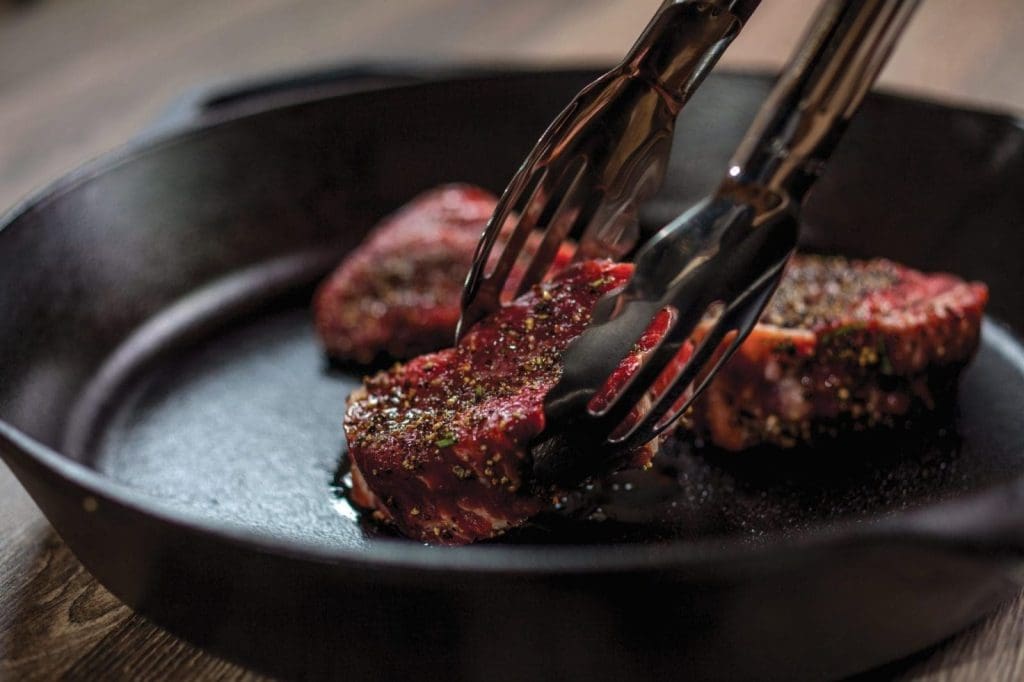Whether you’re whipping up Sunday brunch or braving Julia Child’s Boeuf Bourguignon, a little kitchen know-how can go a long way. Although your recipe repertoire might need a little revamping, it’s important that you walk before you run. Or in this case, brown the meat before you braise. Understanding a few tried-and-true techniques is what’s going to take you from a nervous novice, to a cook with confidence ready to conquer. Here, we’re breaking down six professional chef techniques to master at home.
1. Building a Vinaigrette
The most basic ratio to building a vinaigrette is one part acid to three or four parts oil, depending on your taste. Aside from that, you’re also going to want a salty and sweet component. It’s all about balance. Adding sugar will counteract the acidity in the dressing, and either punch up or mellow out your other flavors. Think about adding a drop or two of honey, maple syrup or agave next time.

2. Making a Pan Sauce
Sauce is often a forgotten component when cooking at home, but it’s what truly makes a composed dish. Put those pan drippings or leftover chicken stock to good use and don’t forget the roux. A roux is a thickening agent that’s going to give your sauce body and that rich, velvety texture you get in a restaurant.
A standard roux is always equal parts fat and flour. For every quart of liquid, you’ll need half a pound of butter and half a pound of flour. Just make sure you cook out all the raw flour first, which can take anywhere from five to 20 minutes.
3. Melting Chocolate
Melted chocolate can be used as a base for truffles, brownies, frosting or simply dipping and drizzling over ice cream. The key to getting it soft and silky is to use a double boiler. A double boiler heats the chocolate indirectly by steaming it gently from underneath so the sauce won’t get scorched. This is a slow process, but you’ll want to stir continuously over low heat.
If you don’t have a double boiler at home, you can take a heatproof bowl and place it on top of a pot of simmering water. Be careful, you never want the water to come into contact with the bowl itself. Instead, just simmer slightly in the saucepan.

4. Poaching an Egg
The most impressive egg presentation by far is poached, but of all the professional chef techniques to master at home, the effort exerted isn’t always worth the payoff. We know, we’ve tried. Your cast of ingredients include eggs (obviously), but make sure they’re fresh, along with a tablespoon of white vinegar and salted water. Stir the water in a whirlpool motion before dropping your egg in, making sure it never boils and stays at a steady simmer.
The swirling will help the whites actually coat the yolk and the added vinegar allows the whites to stiffen up. Before pulling the egg out of the water, you’ll want to test it for doneness by scooping it up with a slotted spoon to make sure the yolk is still soft, and the whites are firm.
5. Searing Protein
There’s nothing better than a filet that’s got a nice crispy crust to it. The only way to achieve that at home is to not fear the flame. The pan needs to be hot enough that the natural sugars in the meat will caramelize, giving the protein that beautiful brown color and flavor.
To ensure the perfect sear, you’ll want to pat your meat dry to start and don’t overcrowd the pan once you’ve placed it in. It’s best to use a cast iron pan or something similar because its heavy bottom retains the most amount of heat and distributes it evenly. Once your protein is in the pan, watch it carefully but don’t touch until it’s ready to be turned.

6. Seasoning Properly
If you’ve followed a recipe to a T, but by the end it’s either over or under seasoned, you have failed. OK, it’s not that big of a deal, but we can all agree that bland food tastes, well, bland. You want to season every component of the dish at all stages of the cooking process but remember, it’s not about how much you use, but how you use it. Let’s work smarter, not harder.
Different types of salt will also affect the overall taste and texture of a dish and knowing which kind to use is just as important. Kosher salt is preferred by professionals because it not only feels good on the hands which makes it easier to pick up, it also has zero impurities. Let’s just say that if it’s good enough for Salt Bae, it’s good enough for you.
Abby is The Digest's Managing Editor. She spends her time looking at dogs on Instagram and eating her way around Jersey City.
- Abby Montanezhttps://thedigestonline.com/author/abby/
- Abby Montanezhttps://thedigestonline.com/author/abby/
- Abby Montanezhttps://thedigestonline.com/author/abby/
- Abby Montanezhttps://thedigestonline.com/author/abby/


